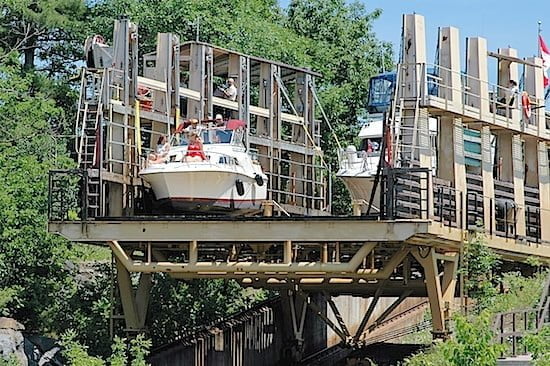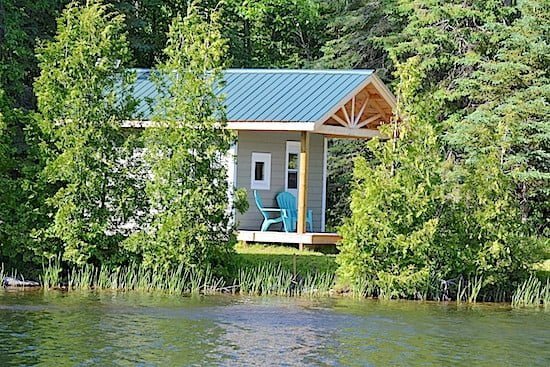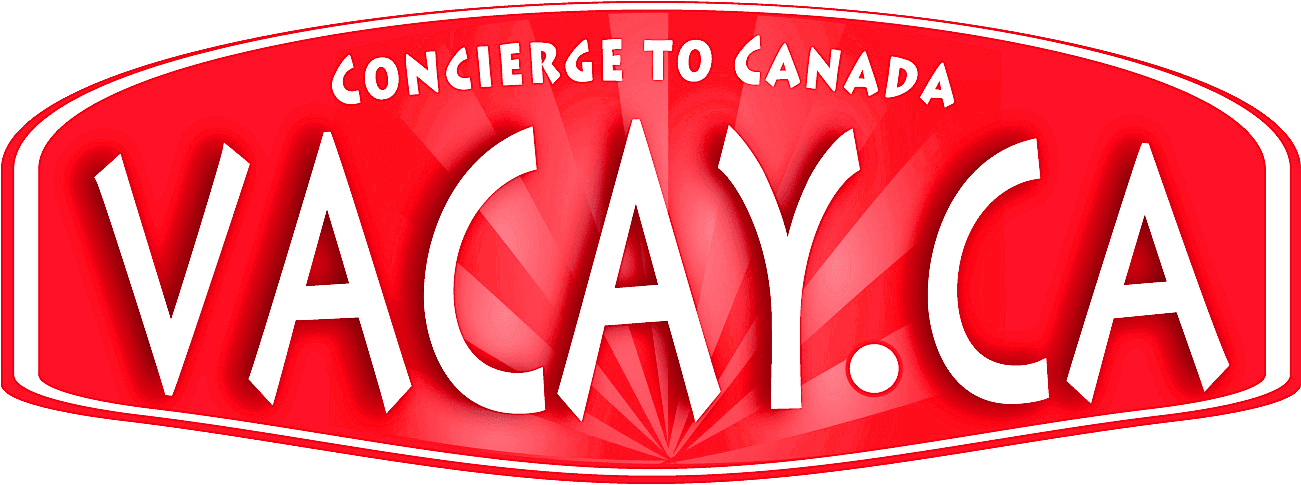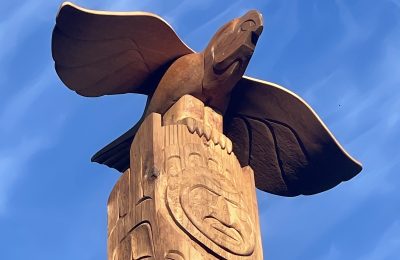
Boats pass through the locks in Bobcaygeon, one of the picturesque towns along central Ontario’s Trent-Severn Waterway. (Jamie Ross/Vacay.ca)
Story by Jamie Ross
Vacay.ca Writer
TRENT, ONTARIO — I attempt to push out the night’s cobwebs with a cup of coffee, while watching the sun come up over the Severn River. Wispy mist rises from the warm water like dragon’s breath; it swirls and drifts. The haunting call of a distant loon echoes across the smoky river surface. The silhouette of a man can be seen by the upper lock gates, fishing rod in hand.
I have always been excited by the mysteries of river travel. Voyaging aboard a large cruise ship across the ocean has never held much fascination for me, but a slow boat down a meandering, well-travelled waterway stokes my imagination. After reading Mark Twain, what spirited youngster has not dreamt of being Huck Finn, drifting down a river’s wide expanse by raft, canoe or boat, the changing scenery, passing vessels, the bustle of activity and the characters you meet lead to new adventures and fresh discoveries around every bend? Now, I am not comparing Twain’s mighty Mississippi with the Trent-Severn Waterway, but much of the same magic is at work.

The Marine Railway is the nickname of a connecting passage through the Trent-Severn Waterway that delivers boaters and their vessels into the stretch of river called Big Chute. (Jamie Ross/Vacay.ca)
We are at Lock 43, and have just spent the last night of our week-long journey. I think back on the trip, and I am sad to know it is coming to an end. By the end of the day we will have travelled 386 kilometres (240 miles) through the canal system, a linear National Historic Site of Canada, from Lake Ontario to Georgian Bay. We will have passed through 36 conventional locks, two flight locks, two twin-level lift locks, and down one marine railway.
All are engineering marvels, built some hundred years ago. We will have journeyed along 53 kilometres (33 miles) of excavated canals, narrow and shallow ribbons of water that have managed, with their locks, to defy the barriers of watersheds, linking manmade channels to the existing rivers and lakes.
Although you are never really far from civilization, it is a journey that at times gives you the impression of being worlds away. At other times you feel front and centre, in the middle of the excitement, concerts, festivals and activities that mark the charming towns along the route. On this early morning it is all peace and quiet, as I marvel at the stillness of the lock, and think back to highlights enjoyed along the way.
The Otonobee River running north from Rice Lake to Peterborough is a wonderful stretch, hedged on both sides by wetlands and home to a great variety of birds. Great blue herons, bald eagles and ospreys take flight at our approach. We see a mother loon with two chicks tucked beneath her wings. She hoots quietly, and I wonder if she is telling her brood to stay hidden, but then her mate appears. She was likely calling softly to him, “A little help please.” One of the youngsters climbs onto its mother’s back for a ride. Gnarled willow trees lean out over the banks creating a canopy, while cattails and wild rice spring from the wetlands. It is as I imagine a meandering river through the everglades would appear, minus the gators.

The Lockmasters Cabin in the small town of Rosedale is one of the many cottage properties running along the watery routes of Ontario. (Jamie Ross/Vacay.ca)
The guardian of the Trent Severn is Parks Canada, and we found its lock operators extraordinarily friendly, considering the operational mayhem they must face each day.
“Love the job,” says Nick Angers, Lock 19 lockmaster, as he helps garner control of a huge yacht that bounced into the lock behind us. Angers has enjoyed a lifelong love affair with the waterway. His father has worked as a lock attendant for more than 30 years. Angers would accompany his dad to work as a youngster and realized early on this job was also what he wanted for his career. We would meet his father, Pat, farther up the system at Buckhorn Lake.
Peterborough is the electric heartbeat of the waterway. We spend our second night on the waterway at the city’s downtown marina, check in at the Holiday Inn Waterfront, and take in the weekend Kawartha Craft Beer Festival. We had planned to spend an hour or so sampling the best in local brews and feasting on oven-fired pizza, but the entertainment was so good we closed things out. The next morning it was breakfast at the Silver Bean Café and then the colour and pageantry of some Dragonboat racing on Little Lake, just off the main channel. We talked to a few boaters who had landed in Peterborough and stayed, returning each summer to their own personalized slip at the marina.
Unfortunately, we had to move on, through the amazing Peterborough Liftlock, the highest of its kind in the world. That stop was followed by a visit to Lock 24 and the wonderful Parks Canada o’TENT’iks, glamping at its finest. We pulled our bikes off the boat and cycled the trails to the charming little hamlet of Lakefield for a cold pint and some appetizers at the Canoe and Paddle pub. Afterwards we headed back to our o’TENT’ik to throw some steaks on the grill and watch a dazzling sunset over the water.
History of Ontario’s Historic Waterway
The Trent-Severn Waterway was not constructed with us, the casual, fun-loving cruiser, in mind. Its completion in 1920, after 87 years of sporadic construction, marked the realization of a century-and-a-half-old dream, born out of a fear of American expansionist interests and spurned along by commercial transport desires. However, by the time the motor launch Irene made the first passage of the system that summer, logging was in decline and railways were burgeoning as an economical means of moving goods. By the 1940s, there was not enough traffic on the waterway to warrant keeping it open. The post-war economy saved the system, as people found they had the time and money for pleasure boating. Locks that handled some 2,000 vessels in the early 1950s now see more than 250,000 each summer.
Today, the Parks Canada locks each have its own particular personality and charm, and stand as the centrepieces of the delightful towns along the route: Campbellford, Hastings, Lakefield, Bobcaygeon, Buckhorn and Fenelon Falls.
One of our favourite nights was spent in the new Lockmasters Cabin at Lock 35 Rosedale. It is a replica of the Lockmaster’s Watch House, circa 1920, built at Bobcaygeon, but ours is built for comfort, with a beautiful view back along the channels and wetlands that stretch towards Cameron Lake. After biking around the Dewey Island Nature Reserve, on which our cabin is situated, we enjoyed a peaceful bonfire, and were treated to an amazing light show courtesy of hundreds of fireflies.
Scenic River Tour Near Toronto
We passed through the second lift lock on the system at Kirkfield, which stands as the high watermark and watershed divide. After slowly making our way through a series of locks, we were able to pick up speed across the chop of Lake Simcoe and the shallow expanses of Lake Couchiching to Lock 42 and the Severn River. Here, we meandered along in the early afternoon sunshine, enjoying the subtle beauties of marsh and meadows. Around every river bend new life emerged; beavers dove with a slap of their tail, muskrats sat on reed beds chewing on tender shoots, ducks scurried to safety with brood in tow.

Parks Canada has developed luxury glamping facilities with its unique o’TENT’iks brand of accommodations. (Jamie Ross/Vacay.ca)
After a leisurely day, we pull into the picturesque campsite above the Swift Rapids Lock. We enjoy a barbecue on the grassy lawns that hedge the river, and then join a half-dozen other boaters around a roaring bonfire.
The next morning, we set off westward on our final leg, along the deeply gorged Severn River through what has been called the wild end of the waterway. The Marine Railway at Big Chute is another in the series of engineering marvels along the system, a virtual roller-coaster for boats, the railway wheeling vessels out of the water and down the 18-metre (59 miles) slope between the Severn River and Gloucester Pool. On this day, we are lowered slowly and gently down the grade, the massive cables holding firm.
We navigate the clear waters through the hidden shoals, pre-Cambrian granite gorges and rocky channels, past scenery that is delectably Canadian. On either shore we witness an amazing cross-section of cottage life, with every type of recreational home, bungalow and cabin on display. Cottages hug the shoreline and cling to craggy knolls, rock outcrops and ragged clifftops, much like the towering, elegant pines, and bizarrely twisted conifer trunks and root systems that hang on precariously to the minutest amounts of soil.
Children swim off docks, or daringly leap off towering cliffs. Some are pulled around on bouncing tubes or ski in nearby bays. Adults relax with a fishing line in the water or lounge on their docks.
At Big Chute we meet some cruisers from the Eastern Seaboard of the United States in the midst of a circuit that takes them up the St. Lawrence River, through this waterway and the Great Lakes, and eventually out the Mississippi to the Gulf of Mexico. They will be on the water for six months or so. Our week-long Trent-Severn trip seems nowhere near as ambitious, but it was a journey that allowed us to glimpse an enchanting and captivating part of small-town Ontario, amiable villages that thrive in a unique partnership with the waterway.
What we discovered in our brief travels was a desire to slow down. We idled along, allowing ourselves to get lost in the locks, the wind and sun putting a glow on our faces and our spirits. With the magnificent scenery and the steady, seductive rhythm of the rivers and lakes, we found that the watery miles glided effortlessly past.
MORE ABOUT VISITING THE TRENT-SEVERN WATERWAY
Visiting in 2017: Parks Canada will offer free lockage in 2017 on both the Rideau and Trent-Severn Waterways to celebrate Canada’s 150th birthday. If you want to do some camping or glamping along the route, consider booking the o’TENT’iks or the Rosedale Lockmaster’s Cabin. Visit the Parks Canada website for more details.
More Info: Peterborough & the Kawartha’s Tourism is a great help through the heart of the waterway system, and can give advice on accommodation, restaurants and special events along the route. Visit www.thekawarthas.ca and www.peterboroughcanada.com.
Houseboats: If you don’t have your own boat, how about a rental? Two outfits that will set you up with your own luxurious houseboat, complete with skippering instructions, are Egan Houseboats and Happy Days Houseboats.






